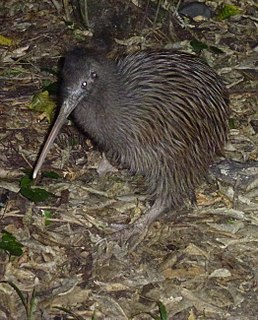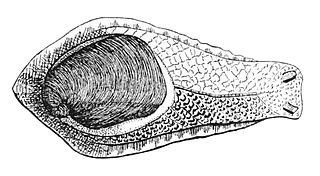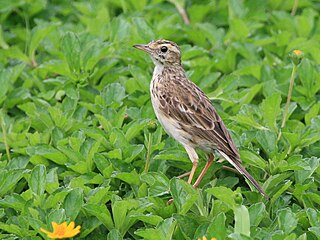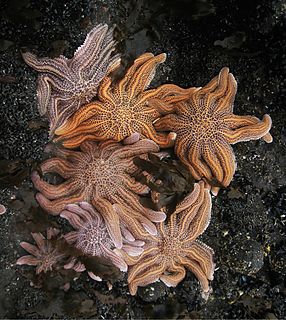
Kiwi are flightless birds endemic to New Zealand of the genus Apteryx and family Apterygidae. Approximately the size of a domestic chicken, kiwi are by far the smallest living ratites.

The weka, also known as the Māori hen or woodhen is a flightless bird species of the rail family. It is endemic to New Zealand. It is the only extant member of the genus Gallirallus. Four subspecies are recognized but only two (northern/southern) are supported by genetic evidence.

The South Island robin, also known in Māori as the Kakaruwai., is a sparrow-sized bird found only in New Zealand, where it has the status of a protected endemic species. The birds are sparsely distributed through the South Island and Stewart Island/Rakiura, although the distribution is not continuous. The nominate, and the Stewart Island robin are the two subspecies. The species is closely related to the North Island robin, and also to the extremely rare black robin of the Chatham Islands.

The southern brown kiwi, tokoeka, or common kiwi is a species of kiwi from South Island, New Zealand. Until 2000 it was considered conspecific with the North Island brown kiwi, and still is by some authorities.

The Okarito kiwi, also known as the rowi or Okarito brown kiwi, is a member of the kiwi family Apterygidae, described as new to science in 2003. The species is part of the brown kiwi complex, and is morphologically very similar to other members of that complex. It is found in a restricted area of the Ōkārito forest on the West Coast of New Zealand's South Island, and has a population of only about 600 birds.

The North Island brown kiwi is a species of kiwi that is widespread in the northern two-thirds of the North Island of New Zealand and, with about 35,000 remaining, it is the most common kiwi. It holds the world record for laying the largest eggs relative to its body size.

Captain Frederick Wollaston Hutton was an English-New Zealand scientist who applied the theory of natural selection to explain the origins and nature of the natural history of New Zealand. An army officer in early life, he then had an academic career in geology and biology. He became one of the most able and prolific nineteenth century naturalists of New Zealand.

The pouched lamprey, also known as the korokoro or wide-mouthed lamprey, is a species in the genus Geotria, which is the only genus in the family Geotriidae. The second species in the genus is the Argentinian lamprey, which was revalidated as a separate species in 2020. The pouched lamprey is native to the southern hemisphere. It spends the early part of its life in fresh water, migrating to the sea as an adult, and returning to fresh water to spawn and die.

Rhytididae is a taxonomic family of medium-sized predatory air-breathing land snails, carnivorous terrestrial pulmonate gastropod molluscs in the superfamily Rhytidoidea.

Schizoglossa, common name the Paua slugs, is a genus of medium-sized to large predatory, air-breathing, land slugs, carnivorous terrestrial pulmonate gastropod molluscs in the family Rhytididae. They are currently classified by the New Zealand Department of Conservation as Nationally Vulnerable.

Wainuia is a genus of air-breathing predatory land snails, terrestrial pulmonate gastropod molluscs in the family Rhytididae. Species in this genus occur in New Zealand.

Rhytida is a genus of medium-sized, air-breathing, predatory land snails, terrestrial pulmonate gastropod molluscs in the family Rhytididae.
Rhytida meesoni is a species of small, air-breathing land snail, a terrestrial pulmonate gastropod mollusc in the family Rhytididae.
Rhytida patula is a species of medium-sized, air-breathing land snail, a terrestrial pulmonate gastropod mollusc in the family Rhytididae.
Rhytida greenwoodi is a species of medium-sized, air-breathing predatory land snail, a terrestrial pulmonate gastropod mollusc in the family Rhytididae.

The Australasian pipit is a fairly small passerine bird of open country in Australia, New Zealand and New Guinea. It belongs to the pipit genus Anthus in the family Motacillidae.

Telogaster opisthorchis is an endoparasite in the class Trematoda within the phylum Platyhelminthes. This fluke is known for causing tumor like malformations in fishes by attaching onto its spinal region in the metacercariae form. Malformations cause fish to become more susceptible to fish eating predators allowing T. opisthorchis to continue with its lifecycle.

Stichaster australis, the reef starfish, is a species of starfish found in the shallow waters of the rocky intertidal of New Zealand. Typically, the animal is endemic to the west coast shores of the North and South Islands, where wave action is increased. They do not usually inhabit ecosystems that have reduced wave action and calm conditions as they prefer a higher-energy environment. These marine invertebrates range in color from pink to purple, but can also be orange. They typically have eleven arms, but sometimes they may have either ten or twelve. As full-grown adults, they are 8 to 10 cm in diameter.

Anthrenocerus australis is a species of beetle belonging to the Dermestidae family. It is commonly known as the Australian carpet beetle and is one of the most researched of the thirty-one species in the Anthrenocerus genus. This is generally attributed to its prevalence throughout Australia and New Zealand and the negative economic and agricultural impact it has as a pest. It is the larvae that causes damage to products, not the adult beetle. The total life cycle of this insect is around three years, most of which is spent as a larva. Once the beetle reaches maturity, it only lives for between two and six weeks.
Aedes australis is a brackish water mosquito species from the subgenus Halaedes. It is native to Australia. It was first found in New Zealand in 1961 and is now present in the southern half of the South Island.















